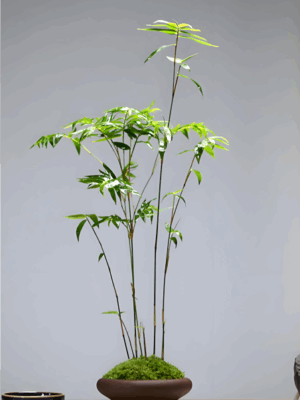The Bodhi tree (scientific name: Ficus religiosa L.) is an evergreen tree in the Ficus genus of the Moraceae family. Its bark is gray white, and its leaves are oval with serrated edges. The flowering period is from March to April, and the fruiting period is from May to June. Its name comes from the legend that Shakyamuni attained enlightenment and became a Buddha under this tree, and “Bodhi” means “enlightenment” in Sanskrit.
Plant characteristics and distribution
Morphological features: The tree can reach a height of 15-25 meters and a diameter at breast height of 30-50 centimeters; Ficus fruit is spherical and red when ripe; The leaves are leathery, triangular ovate in shape, and the tips of the leaves extend into a tail shape.
Distribution range: Native to South Asia such as India and Bangladesh, widely cultivated in southern China, prefers sunny and humid environments but avoids waterlogging.
Cultural and Religious Significance
Buddhist symbol: The Bodhi tree is regarded as a symbol of wisdom and enlightenment, and is often planted in temples to symbolize divine inheritance.
Cultural significance: It is believed by the people that it can ward off evil spirits in homes, and heart-shaped leaves are also endowed with the meaning of love and blessings.
practical value
Ecological use: Tall tree shape, suitable for courtyard greening; Strong resistance to hydrofluoric acid and can be used for greening in polluted areas.
Economic value: Milk can be used to extract hard rubber, branches and leaves can be used as livestock feed, and wood can be used to make cutting boards, etc.
Medicinal value: bark and leaves can be used as medicine, with the effects of clearing heat, drying dampness, calming the mind and regulating the body.
If you need to further understand its cultivation or cultural details, you can refer to Baidu Baike or Buddhist Culture Baike.
菩提树(学名:Ficus religiosa L.)是桑科榕属常绿乔木,树皮灰白色,叶片卵圆形边缘具锯齿,花期3-4月,果期5-6月。其名称源于释迦牟尼在此树下悟道成佛的传说,“菩提”在梵语中意为“觉悟”。
植物特征与分布
形态特征:树高可达15-25米,胸径30-50厘米;榕果球形,成熟时红色;叶片革质,三角状卵形,叶尖延伸为尾状。
分布范围:原产于印度、孟加拉国等南亚地区,中国南方广泛栽培,喜阳光充足、湿润但忌积水的环境。
文化与宗教意义
佛教象征:菩提树被视为智慧与觉悟的象征,寺庙中常种植以表神圣传承。
文化寓意:民间认为其能镇宅驱邪,心形叶片亦被赋予爱情祝福的寓意。
实用价值
生态用途:树形高大,适合庭院绿化;对氢氟酸抗性强,可用于污染区绿化。
经济价值:乳汁可提取硬性橡胶,枝叶作牲畜饲料,木材用于制作砧板等。
药用价值:树皮、叶片可入药,具清热燥湿、安神定志之效。
如需进一步了解其栽培或文化细节,可参考百度百科或佛教文化百科。





评价
目前还没有评价